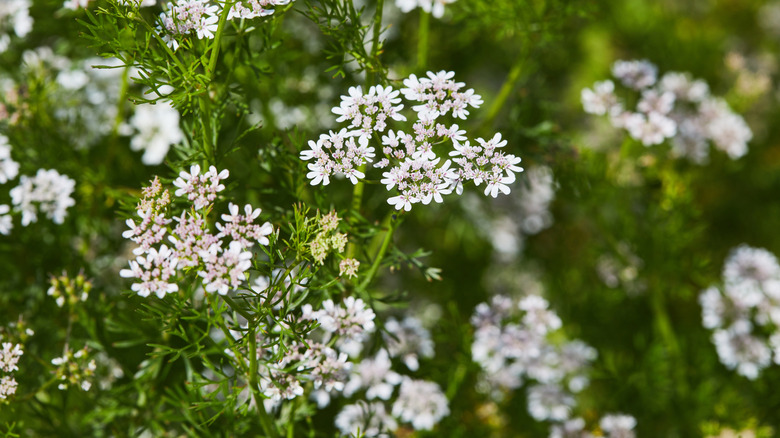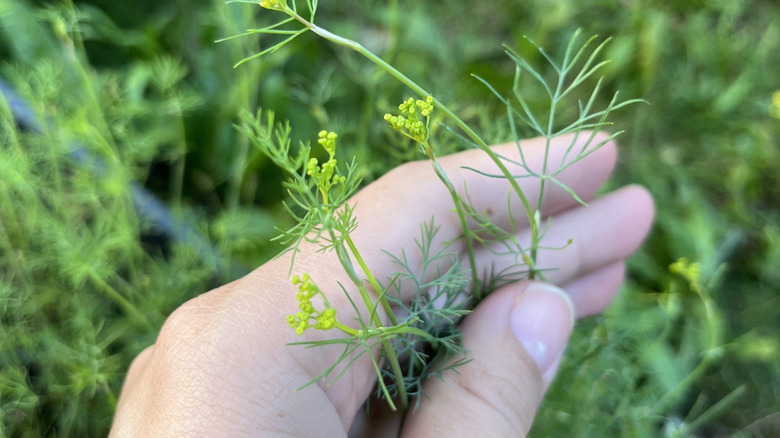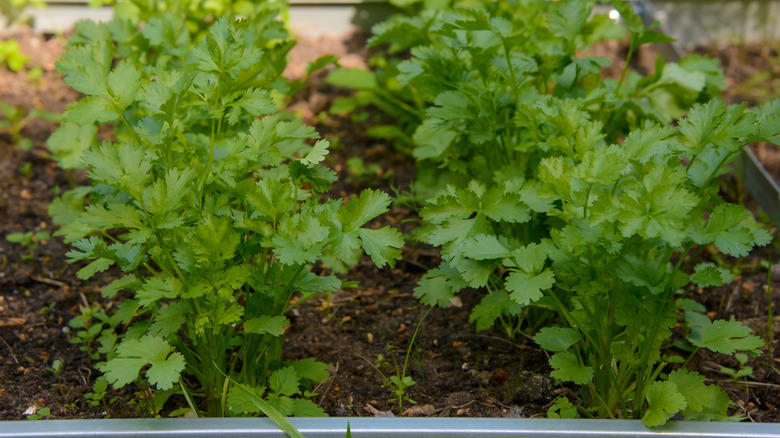The Mistake You're Making That Is Causing Your Cilantro And Dill To Flower Too Quickly
If you want your garden to be functional as well as beautiful, herbs are the perfect plant. Both cilantro and dill are easy to grow from seed and can be used in a wide variety of delicious dishes. However, each plant is only harvestable for a short time, and if they flower too quickly, that time is cut even shorter. To avoid this problem, make sure to plant your cilantro and dill when the weather is still cool.
Cilantro and dill are in the Apiaceae family of plants, along with plants like carrots and parsley. Flavor-wise, they're very different, but in the garden, they require similar care; cilantro and dill make great companion plants. They are also both prone to flowering prematurely — known as "bolting" — if conditions get hot and dry. Other factors can cause bolting too, including cold spells and changes in daylight. Bolting can occur whenever a plant is stressed enough that it begins to prioritize reproduction so the next generation of plants can survive after it dies.
Bolting is undesirable for cilantro and dill because the leaves and stems become less flavorful as the plant sends most of its energy toward flower and seed production. If you were wondering why your home-grown cilantro tastes so bitter, bolting could be the culprit. Plus, flowering signals the end of the road for cilantro and dill since they are grown as annual plants. These herbs are so prone to quick flowering that it can be hard to stop it completely, but you can delay it long enough to get a more satisfying harvest.
How to delay flowering in cilantro and dill
The best way to prevent your cilantro and dill from flowering too quickly is to plan ahead — before any seeds go into the ground. Once temperatures get high enough, bolting is inevitable, so start your cilantro and dill seeds early enough in the season that you can enjoy a lengthy harvest before their time is done. The best time of year to plant dill in your garden is early spring as soon as the last frost is over. The same goes for cilantro. If you live in a very hot climate, stick to growing these herbs in the winter. The more you protect these herbs from high heat, the longer they can go without flowering.
Additionally, it's best to direct sow cilantro and dill rather than sowing indoors first or buying starters. The transplant process is a stressor that makes bolting more likely. Another technique that allows you get a longer harvest even after some of the plants bolt is succession planting: Sow seeds every couple of weeks, rather than all at once, so each set of plants matures at different times.
Lastly, choose a "slow-bolt" or "bolt-resistant" variety of cilantro and dill to increase your chances of success. You can also look for local seeds that may be more adapted to your climate. And if your climate is too tough on these cool-weather-loving herbs, you can always grow cilantro indoors on a windowsill with your dill.
Ways to stop bolting in its tracks
You can tell that a plant is about to bolt when it starts growing much taller stems and the leaves get smaller, thinner, and sometimes yellow. Those tall stems will eventually produce flowers. To stall the process, cut back those stems as soon as you spot them so the plant redirects its resources to producing leaves. Regularly harvesting your cilantro and dill is also wise, especially the older leaves; this encourages the plant to produce more leaves rather than flower. Fertilizing with a nitrogen-rich fertilizer also supports leaf production.
Optimizing your herbs' growing conditions can also keep them producing for longer. Heat, drought, and cold are all surefire ways to get your plants to bolt. Instead, offer your plants some shade during the hottest parts of the day, water consistently especially during dry bouts, and protect them from cold spells. Once daylight lasts longer than 12 hours per day, bolting may also be imminent, but there's little you can do on that front aside from growing indoors with a grow light.
It's important to note that flowering is a natural part of the cilantro and dill life cycle. Once your herbs are past the point of no return, there's not much you can do but sow more seeds another time. It's not all bad news for gardeners either: cilantro and dill seeds are both edible (cilantro seeds are known as coriander), and the flowers are edible, ornamental, and they attract pollinators. By leaving the seeds in the garden, you're likely to get a fresh batch in the same spot next year.


